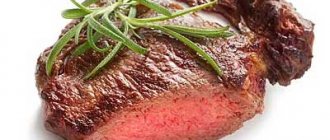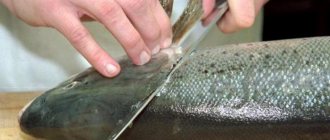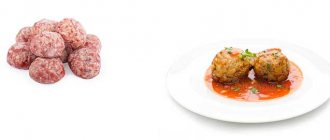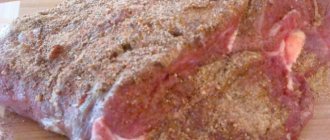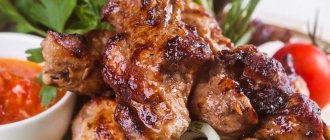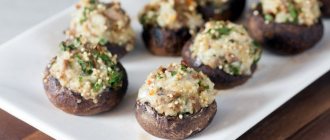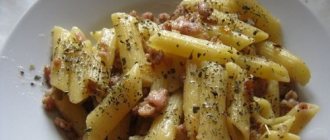11.27.2014 / Meat products
| Boiled pork, BJU and calorie content per 100 g of product | |||
| Calorie content 233 kcal | Proteins 16.4 g | Fat 18.3 g | Carbohydrates 1 g |
Buzhenina is a dish known since the 16th century. At its core, it is boneless meat, boiled in a whole piece and rubbed with spices. Previously, this dish was prepared from bear meat, but nowadays pork is most often used to prepare boiled pork. For boiled pork, the right choice of meat is very important. It is best to choose the neck; the layers of fat in the piece will prevent the dish from drying out. Ham is less suitable for boiled pork, but it has its place as an option. And, of course, the meat must be fresh, preferably fresh.
Useful properties of boiled pork
Depending on the chosen meat, boiled pork contains from 200 to 300 calories, up to 17 g of protein, up to 19 g of fat, and up to 2 g of carbohydrates.
Baked pork, the safest of sausages. Ideally, it is prepared by simply baking a piece of meat in the oven, adding garlic and spices.
Baked pork is easy to prepare at home.
Rub the meat with salt and pepper, and you can use any red or black pepper, and sprinkle chopped garlic on top. You can make small cuts in the meat and insert garlic into them, just so that it doesn’t fall out.
We place the prepared meat on a sheet lightly greased with vegetable oil, and, of course, send it to bake in an oven preheated to 180^(o)C. (Or in a double boiler) During cooking, the meat should be periodically turned over and basted with the released fat so that it is well baked on both sides and does not burn. It’s very easy to check the readiness, just pierce the meat with a sharp knife and see if the juice flows out, it means it’s cooked through.
By the way, steamed boiled pork is an excellent dish for those who cannot eat fried pork.
Dangerous properties of boiled pork
Baked pork, like any meat, has a number of standard harmful properties and contraindications. Because Since it is made from pork meat, it contains a lot of cholesterol and lipids, which are contraindicated for overweight and obese people. Also, the high content of these substances negatively affects the state of the cardiovascular system, so people who have heart problems are better off limiting the amount of boiled pork in their diet.
In one of the episodes of the program “Everything Will Be Delicious,” all the secrets of preparing juicy boiled pork were revealed. Find out about them and please your loved ones with delicious meat.
We like to bake meat in a large piece, and most often choose pork for this. This meat is usually called boiled pork and is served cold, cut into thin slices. Sometimes the boiled pork turns out juicy and soft, and other times it turns out gray, stringy and so dry that you can’t push it through without sauce. What's the matter and how to achieve consistently successful results?
Our regular author, gastronomic journalist and practicing culinary specialist Alena Spirina decided to conduct an experiment and test in practice how the choice of temperature for cooking meat for a specific cut affects the result. In the editorial kitchen of the Gastronome, she baked 4 different pieces of pork in two ways. Here is an account of how it happened.
First you need to choose the appropriate cut. Most often, they buy ham for boiled pork - the back part of a pork carcass. A properly cut ham is covered with a layer of fat. This is good because, as you know, fat is a conductor of taste, and it also protects meat from the heat of the oven. On the other hand, ham consists of two different types of meat: juicy “red” and dry “white”, the fibers of which are located, moreover, almost perpendicular to each other. This makes cooking a little more difficult because you don’t want to dry out the white meat.
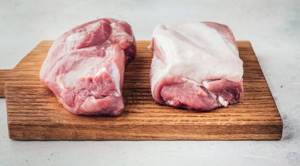
Most often people buy ham for boiled pork - the back part of a pork carcass.
Another cut that can be used for roasting is the shoulder, that is, the boneless flesh of the front leg. It contains less fat, but the structure of the meat is more uniform, the muscle fibers are thinner, which means the baked meat should be softer. But there is much less fat in the shoulder blade, and this worries us.
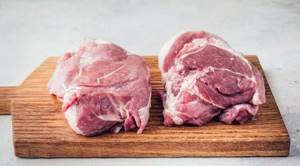
Another cut that can be used for roasting is the shoulder blade.
For the experiment, we bought four pieces of chilled boneless pork. They were vacuum packed and weighed about a kilogram. Two were labeled “ham,” the other two were labeled “shoulder.” As you can see in the photo, pieces of meat with the same names looked completely different. One piece of ham is evenly covered with a thin layer of fat, the second is completely without fat and two shades of meat color are clearly distinguishable in it. The shoulder blade pieces are more uniform in color, but, unfortunately, they cannot be called compact. The most “torn” piece even had to be tied with twine.
The danger of boiled pork

The tastier the dish, the more difficult it is to stay “within the limits” that nutritionists outline as “not to abuse.” And boiled pork is one of the first dishes on this list. Considering the rather high calorie content of meat, it should appear in small portions and infrequently in the diet of people with obesity, high cholesterol and cardiovascular diseases. This warning primarily applies to the classic version - made from fatty pork.
But it is also unsafe to abuse stuffed beef. The purines contained in this type of meat increase the level of uric acid, and this can already be dangerous for people with osteochondrosis or gout. By the way, nutritionists advise consuming no more than 70 g of the product at one sitting.
Well, the main danger of boiled pork is parasites and bacteria. The first danger is possible if the meat was not fully baked. The second is if it is stored at the wrong temperature or its expiration date has expired.
The magic of salt
After assessing the appearance of the meat and choosing a cooking strategy for these cuts, the first thing we did was salt them.
Because any meat that we plan to cook in large pieces should be salted in advance. In advance - because it will take time for the salt to penetrate into the thickness of the meat and salt it from the inside. A small amount of salt used in advance will season the meat better than a lot of salt applied just before or after cooking. That is, the time allotted for salt to work is more important than its quantity.
Salt not only seasons the meat, making it tastier, but also helps soften the meat proteins. Imagine that meat proteins are a wire twisted into a weak spiral, to the outer surface of which water molecules are attached. When heated, the spiral contracts, water molecules break away from its surface and escape from the meat, leaving it dry and tough. Salt softens the proteins, prevents them from curdling and forming lumps, water molecules remain in their places, and the piece of meat turns out juicy. And we have a chance not to dry out the meat. It is advisable to salt a piece of meat a day, maximum two days before cooking. The sooner the better, but it can take a few hours. In any case, better late than never. It is not advisable to salt it more than two days in advance, because it will be more like preserving meat than pre-salting.
You can salt the meat either directly, taking salt at the rate of 1.25% by weight of the piece, or by immersing the meat in a salt solution, which is prepared at the rate of 6% salt by weight of water. If you don’t have time, you can resort to “emergency therapy”: fill a syringe with saline solution and inject it into the meat. The solution should be at room temperature, it is only important that the salt is completely dissolved.
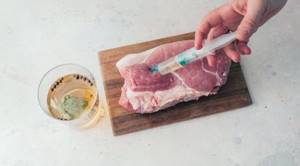
If there is no time for brine, you can resort to “emergency therapy”: fill a syringe with saline solution and inject it into the meat
We did this: we took 200 ml of water, added 30 g of salt, 5 peas of black and allspice and a couple of bay leaves. Heat until the salt dissolves and a pleasant aroma of spices appears. Remove from heat, pour into a measuring cup and add enough cold water so that the total volume of liquid is 500 ml. Then they filled a syringe with this solution, “pumped up” all four pieces and left them to lie on the table while they prepared other products and preheated the oven.
It must be said that the higher the ambient temperature, the less time it will take salt to penetrate the meat. But let's not forget about food safety and limit the time that meat can be at room temperature to two hours, and for longer - in the refrigerator!
How to choose the right cooked pork
Of course, the best boiled pork is boiled pork cooked independently from a selected piece of meat. But the modern rhythm of life does not always allow you to spend several hours preparing food. In such cases, the supermarket comes to the rescue. But when going to the store for baked meat, it is important to know how to choose the right boiled pork.
Tip 1. To begin with, it is important to pay attention to the packaging. It can be vacuum or made from ordinary cling film. Let us immediately note that if you are not 100% confident in the high quality of the product, it is better to refuse boiled pork in cling film. Such a product, as a rule, does not have any indication of expiration date, composition, or manufacturer. But it is also better not to take the vacuum version if this information is missing on it. The second requirement for vacuum packaging is absence of damage.
Tip 2: Now it's time to pay attention to the color of the meat. It should be from light pink to light gray. Any color deviations indicate violations of the cooking technique or old age of the product.
Tip 3. Lard is an important element of the finished dish, but the fat layer should not exceed 3 cm. It is also important to evaluate the color of the lard - it should not be yellow.
Tip 4. A fresh product is a piece of regular oval or round shape.
Tip 5. An important “test” is the composition of boiled pork. The list of ingredients should not contain anything other than meat, salt, spices and garlic. Any “E” indicates that the product is far from natural. It is best if the packaging indicates that the product is manufactured in accordance with GOST.
Tip 6. You can also check the quality of meat using boiling water. If a slice disintegrates into fibers in water, the product is stale.
To the bars!
In foreign books, it is recommended to bake large pieces of meat, placing them on a wire rack made in the shape of the letter V. It is placed on the bottom of a deep baking sheet, into which a little water is poured: the meat, as it were, lies in a hammock, and the juices and fat drip from it into the water and not burn. In the absence of such a thing, we simply chopped the onion coarsely and placed it on the bottom of a deep baking dish. Thick slices of orange were placed on the onions, because it was winter and because oranges are friends with pork. Squeeze out the orange juice and splash in some water. This onion will act as a lattice, preventing the meat from coming into contact with the bottom of the pan and the liquid.
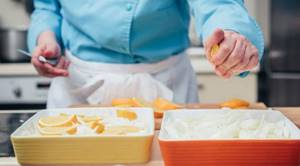
The onion will act as a lattice, preventing the meat from coming into contact with the bottom of the pan and the liquid.
We placed one piece of ham and shoulder on this pillow - according to our plan, they will be baked at different temperatures. Using a sharp knife, we made cuts in the layer of fat so that it melted more evenly, and rubbed the surface of each piece with a mixture of peppers to give them an attractive appearance. Yes, yes, we understand that this will not greatly affect the taste.
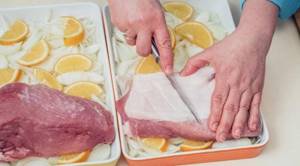
Use a sharp knife to make cuts in the fat layer.
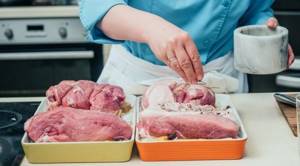
Then rub the surface of each piece with the pepper mixture
Temperature selection
Let's start with the fact that the cooking temperature of pork is defined as 80-85°C for fully cooked meat and 75-80°C for medium-well done (although for some reason it is difficult for us to come to terms with the possibility of such roasting in relation to pork).
There are two ways to reach the desired temperature: quickly at high cooking temperatures and slowly at low temperatures.
As a rule, the following ratio of time and temperature is recommended for baking boiled pork: Option 1: at 220°C for the first 15 minutes, then reduce the temperature to 180°C and calculate the time as 25-30 minutes for every 500 g of meat + 25-30 minutes for piece (time depends on the desired degree of doneness)
Option 2: at 130°C for 3 ½ to 5 hours until the internal temperature of the piece reaches 71°C, then remove from the oven, preheat it to 230°C and return the meat to the oven for 10 minutes.
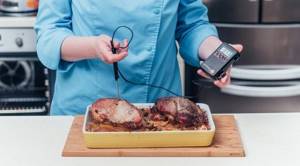
Pork doneness temperature is defined as 80-85°C for fully done meat and 75-80°C for medium done.
We reasoned this way: a ham with a layer of fat can be put in a hot oven, because the meat has a “protective layer.” A piece of a shoulder blade lying nearby met the same fate.
According to the first option, boiled pork was baked to the desired internal temperature for 1 hour 20 minutes, that is, our theoretical calculation turned out to be almost accurate. At low temperature, the meat was baked to 71°C for only three hours (because it’s a small piece), and at high temperature it was baked in less than 10 minutes.
We left the meat under the foil so that the heat was redistributed between the surface and the center, and then we cut each piece to check the result.
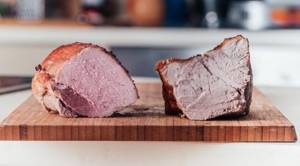
In the top photo is a ham: on the right - baked at a low temperature (Option 2), on the left - according to option 1. The color of the meat is different, but both pieces remained juicy. The fat on the surface seemed to contribute to this.

The bottom photo shows a spatula, the arrangement of the pieces is the same. The blade that was baked at a low temperature turned out juicier (option 2). This was quite predictable: at a low temperature, heat penetrates the meat more evenly and more slowly, as a result - more juicy, not overdried, but at the same time fully cooked meat.
The summary of our experiment with different temperature conditions for cooking boiled pork is as follows:
Meat protected by a layer of fat will turn out juicy when baked at high temperatures, provided the timing is correct. Meat, which is low in fat and connective tissue, will turn out juicier and softer if low-temperature processing is applied to it. But it takes time. In any case, do not forget to salt the meat in a timely manner using any of the methods we have suggested and do not neglect electronic thermometers: they will help to objectively assess the condition of the meat and not overdry it.
Baked pork is baked meat in a large piece using various spices. This dish was prepared many centuries ago, and fatty meat was always chosen for its preparation, as a rule, bear meat. Today boiled pork is most often prepared from pork; less often veal or beef is chosen for this purpose.
You can, of course, choose boiled pork in the store, but when cooked at home, it has the best taste and luxurious aroma. Baked pork can be eaten both hot and cold. This delicacy cannot be classified as a dietary dish, therefore, before sitting down to the table, you need to clarify how many calories are in pork boiled pork.
The calorie content of homemade pork boiled pork is determined only by the calorie content of the meat itself and spices, and ranges from 270 to 500 kcal per 100 g. Despite the fact that homemade baked pork has a high calorie content, you still shouldn’t deny yourself the pleasure. A few pieces of baked pork will help get rid of fatigue and increase vitality and mood. You can reduce the calorie content by preparing boiled pork from beef or choosing pork with lower fat content (without lard). Boiled pork also has a lower nutritional value - about 233 kcal per 100 g.
Hi all! Today I want to introduce you to several recipes for preparing juicy and flavorful boiled pork at home. Most often it is made from pork.
This dish is perfect for serving on a holiday table. For example, as a New Year's snack in addition to salads. And on ordinary weekdays it will also please your household. This meat is an excellent substitute for sausage, as it is good both cold and hot.
To prepare boiled pork, you need to take a whole piece of 1-2 kg. It can be done either in foil or in a sleeve. According to some recipes, it is simply baked in a mold or on a baking sheet without such packaging.
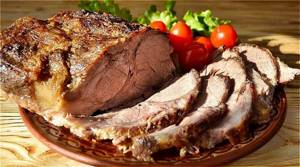
Whatever option you choose, the pork should turn out very juicy, aromatic and incredibly tasty. By the way, a similar meat dish can be made from turkey fillet; you can find such a recipe in the previous article by following the link.
I would also like to draw your attention to the fact that boiled pork is best obtained from the neck part. A ham or tenderloin may also work. The main thing is to have fat in moderation. Therefore, if a piece of meat contains too much fat, the excess needs to be cut off.
What is it made from nowadays?
Classic boiled pork is, of course, the back of a carcass, ham or neck of pork. Less often, they use a boned meatball for baking, but in this case the dish turns out to be quite dry. And a mandatory requirement: the meat for proper boiled pork must have greasy streaks.
True, some prefer leaner versions of the dish - beef or veal. But in this case, in order to avoid overdrying, the meat is covered with lard (it is better to take small slices), and also stuffed with garlic and pork fat. But the technology for baking boiled pork from pork and veal is practically no different. Stuffed veal is first fried over high heat until a crust forms (this will prevent moisture loss), and only then baked.
Another version of the baked delicacy is made from lamb or bear meat. But when choosing these particular products for cooking, it would be a good idea to marinate the meat first (the marinade will remove the specific smell and improve the structure). As a rule, acidified water is used as a marinade for bear meat, and the prepared piece is baked with juniper. To improve the taste of lamb, kefir marinade is suitable, and instead of the traditional garlic and lard “filling”, it is better to use pine nuts, feta cheese and basil.
Poultry lovers have come up with their own dietary version of boiled pork - from turkey or chicken. But red meat connoisseurs refuse to recognize such a dish as boiled pork.
Homemade pork roast baked in foil
To begin with, I want to share this particular recipe with you. Although it is not entirely traditional, since the meat is poured with hot marinade, it produces very tasty boiled pork. So don’t throw tomatoes at me right away, but try it first.
Ingredients:
- Pork neck – 1 kg
- Dried garlic - 0.5 teaspoon
- Paprika - 0.5 teaspoon
- Ground black pepper - 0.5 teaspoon
- Salt - a pinch
- Vegetable oil - 2 tablespoons
For the marinade:
- Water - 1 liter
- Salt - 1 tablespoon
- Allspice peas - 4 pcs.
- Black peppercorns - 15 pcs.
- Cloves - 2 pcs.
- Bay leaf - 2 pcs.
- Garlic - 5-6 cloves
Preparation:
1. First you should prepare the marinade. Pour water into a saucepan and place on fire. When it boils, pour salt into it, add black and allspice, as well as cloves and bay leaves. First chop the garlic and add it to the water. Bring to a boil again and turn off the heat. Leave for 5 minutes to infuse.
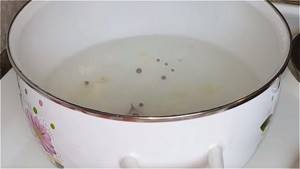
2. Wash a piece of pork and place it in a deep container. Pour hot marinade over it. Make several punctures in the meat so that the inside is better soaked. Close the lid and leave for a day.
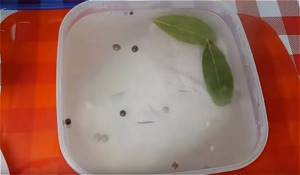
3. After a day you can continue. Take a small container and pour vegetable oil into it. Add salt, pepper, ground paprika and dried garlic. Stir until smooth. Then place the neck on the foil in which you will wrap it and brush the piece on all sides with this mixture.

4. Now wrap it tightly with foil. It's better to take two sheets. First wrap it in one, and then wrap it again in another sheet. Using a toothpick, make about 10 holes in the foil and place in a baking dish.
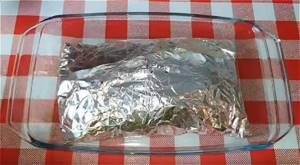
5. Preheat the oven to 200 degrees and place the form with the contents there. You need to bake for 1.5 hours. Then take it out, unwrap the foil and send it back for 10 minutes to brown the meat.
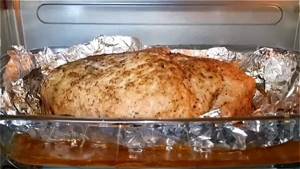
6. After this, remove the pork from the oven and let it cool completely. Then cut it and serve it to your family or guests to try. The boiled pork turns out very aromatic and tasty.

Related Products
Turkey Ham (121 cal) Sliced Ham (107 cal) Cooked Ham (151 cal) Ham Steak (122 cal) Cooked Ham (151 cal) Honey Ham (122 cal) Lean Ham (132 cal) ) Assorted ham (304 cal) Roasted ham (157 cal) Chicken ham (293 cal) Ham roll (241 cal) Leg ham (211 cal) Chopped ham (180 cal) Ham and cheese (241 kcal) Bone-in ham (156 cal) Smoked ham (132 cal) Fried ham (155 cal) Chopped ham (290 cal)
Classic pork boiled pork recipe up the sleeve
This recipe, unlike the first one, is more familiar. The meat is marinated in cold brine and after baking it turns out very tender and aromatic. It can be consumed both cold and hot. In any case, it will be incredibly delicious.
Ingredients:
- Pork neck – 1 kg
- Salt - 3 teaspoons
- Bay leaf - 2 pcs.
- Garlic - 2 cloves
- Ground coriander - 2 tablespoons
- Herbes de Provence - 2 tablespoons
- Water - 1 liter
Preparation:
1. Pour water into a saucepan and bring to a boil. Remove from heat and add salt, bay leaf, 1 tablespoon of ground coriander, 1 tablespoon of Provençal herbs. Stir and leave to cool to room temperature.
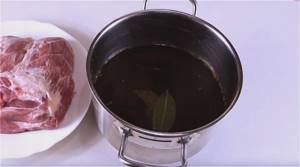
2. Dip the prepared neck into the brine so that it completely covers the meat. Cover with a lid or cling film and refrigerate for at least three hours. You can leave it overnight.
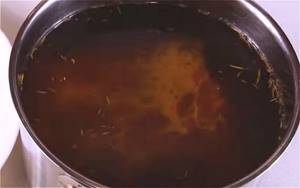
3. After the pork has sat in the brine sufficiently, remove the piece and pat dry with a paper towel. Then add a little more salt and grate with ground coriander and Provençal herbs.
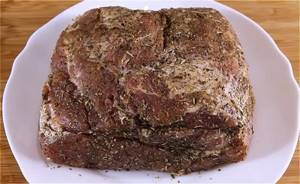
4. Peel the garlic cloves and cut it into thin slices. Make several cuts on both sides of the neck with a knife and place pieces of garlic in them. Then tie a piece of thick cotton (or kitchen) thread to make it more dense and easier to cut.

5. Now place the meat in the sleeve, put the bay leaves that were in the brine there and tie the edges tightly on both sides. Make several punctures in the top of the sleeve to allow air to escape during baking, and place in the pan.

6. Preheat the oven to 190 degrees and place the pork neck in there. Bake for approximately 1.5 hours. Then pull out and cut the sleeve at the top. Send back for another 10 minutes until the meat gets a golden brown crust. Remove the cooked pork from the sleeve and remove the threads.

Baked pork in other portions:
242
2.42
| Qty | A portion | Calories | In the counter |
| 100 g | 242 | ||
| 1 g | 2.42 | ||
| 327 | 1 cup diced = 135g | 327 | |
| 68 | 1 ounce = 28.3g | 68 | |
| 63 | 1 piece = 26g | 63 |
Very tasty and juicy home-made boiled pork with carrots and garlic
This recipe is quite interesting. Although not everyone likes carrots inside meat. However, I still recommend trying it at least once. Mayonnaise is not a necessary unit in the ingredients, so you can cross it out. But that's how I cooked it.
Ingredients:
- Pork – 1 kg
- Garlic - 10-12 cloves
- Carrots (medium) - 1/3 part
- Mayonnaise - 1 tablespoon
- Mustard - 1 tablespoon
- French mustard - 1 tablespoon
- Peppercorns - 10-15 pcs.
- Bay leaf - 2 leaves
- Salt, ground pepper - to taste
Preparation:
1. Wash a piece of pork and pat dry with a paper towel until it is completely dry. Then make several deep and wide cuts. Next, rub the meat with salt and pepper, and don’t forget to salt each hole.
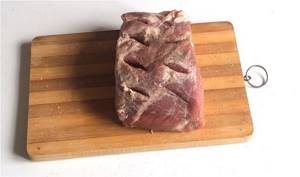
2. Next, rub the piece with regular mustard, covering all sides and holes. Then also grate with mayonnaise. Next, place a clove of garlic and a stick of carrot in each hole. After that, spread French mustard on top and sprinkle with peppercorns. Add 2 bay leaves and leave to marinate for 3 hours. It could be longer.
If the garlic cloves are too large, cut them in half.

3. Wrap the marinated meat completely in foil and place in a baking dish. Place in an oven preheated to 180 degrees for 1 hour. You can check readiness with a toothpick - pierce it and press a little. If clear juice flows out, the pork is ready. Uncover the foil and place back in the oven for 15 minutes. Ready boiled pork can be cleaned of excess marinade with spices and served either hot or cold.
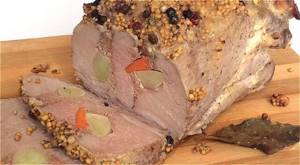
How they cooked it in ancient times
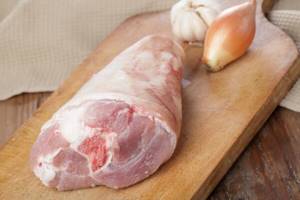
Ancient Slavic cooks prepared boiled pork from boneless pork ham. But there had to be a little lard on the piece, which gave the finished dish juiciness. The pork ham was rubbed with a mixture of spices and salt, stuffed with garlic and lard, and then baked, not forgetting to pour the resulting juice over the meat. And since then, the method of cooking boiled pork has not changed much. Rather, the meat and spices used have changed. And instead of stoves and fires, smarter devices appeared.
Pork neck stew with soy sauce and mustard
This version of cooking boiled pork is my favorite. We skip the process of marinating the meat, but at the same time it tastes simply magical. Although, if you wish, you can keep it in the sauce for several hours for soaking.
Ingredients:
- Pork neck - 1.5 kg
- Garlic – 15 cloves
- Soy sauce - 1 tablespoon
- Mustard - 1 teaspoon
- Ketchup - 3 tablespoons
- Onion - 1 pc.
- Bay leaf - 2 pcs.
- Salt, pepper - to taste
- Spices - nutmeg, red hot pepper, ground ginger, suneli hops, Provençal herbs
Preparation:
1. Rub the neck with salt and pepper on all sides. Cut the garlic into slices (leave three cloves for the marinade). Make several cuts in the meat and stuff with garlic.
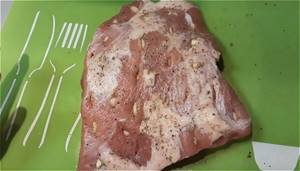
2. Grate the peeled onion and remaining garlic on a fine grater. Place in a deep dish. Add mustard, ketchup, soy sauce, all the spices (0.5 teaspoon each or to taste) and bay leaf (break it). Stir until smooth and brush pork on all sides.

3. Next, place the meat in a sleeve and place in a baking dish. Make several punctures with a toothpick and place in a preheated oven at 180 degrees for 1.5 hours.
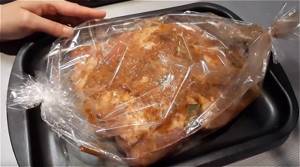
4. After this, cut the sleeve and send for another 10-15 minutes so that our piece browns. As a result, you will get incredibly tasty boiled pork that will simply make your mouth water.
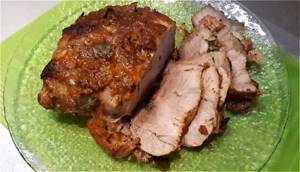
Harm and contraindications
1. Individual intolerance to the product. 2. Allergy to meat. 3. If consumed in excess, it can cause obesity.
CHEMICAL COMPOSITION AND NUTRITIONAL ANALYSIS
Nutritional value and chemical composition of "Brazhenina [PRODUCT REMOVED]".
The table shows the nutritional content (calories, proteins, fats, carbohydrates, vitamins and minerals) per 100 grams of edible portion.
| Nutrient | Quantity | Norm** | % of the norm in 100 g | % of the norm in 100 kcal | 100% normal |
| Calorie content | 510 kcal | 1684 kcal | 30.3% | 5.9% | 330 g |
| Squirrels | 15 g | 76 g | 19.7% | 3.9% | 507 g |
| Fats | 50 g | 56 g | 89.3% | 17.5% | 112 g |
| Water | 40 g | 2273 g | 1.8% | 0.4% | 5683 g |
| Ash | 4 g | ~ | |||
| Vitamins | |||||
| Vitamin RR, NE | 2.49 mg | 20 mg | 12.5% | 2.5% | 803 g |
| Macronutrients | |||||
| Potassium, K | 300 mg | 2500 mg | 12% | 2.4% | 833 g |
| Calcium, Ca | 10 mg | 1000 mg | 1% | 0.2% | 10000 g |
| Magnesium, Mg | 20 mg | 400 mg | 5% | 1% | 2000 g |
| Sodium, Na | 1000 mg | 1300 mg | 76.9% | 15.1% | 130 g |
| Sera, S | 150 mg | 1000 mg | 15% | 2.9% | 667 g |
| Phosphorus, Ph | 200 mg | 800 mg | 25% | 4.9% | 400 g |
| Microelements | |||||
| Iron, Fe | 3 mg | 18 mg | 16.7% | 3.3% | 600 g |
| Yod, I | 7 mcg | 150 mcg | 4.7% | 0.9% | 2143 g |
The energy value of Baked Pork [PRODUCT REMOVED] is 510 kcal.
Main source: Product removed. .
** This table shows the average levels of vitamins and minerals for an adult. If you want to know the norms taking into account your gender, age and other factors, then use the My Healthy Diet app.
Homemade boiled pork with adjika
This method does not require any additional spices. One adjika is enough. I usually take it not very spicy and so that it is not pureed, but in small pieces. It turns out incredibly tasty and aromatic. Try this simple recipe and treat your loved ones.
Ingredients:
- Pork neck - 1.5 kg
- Garlic - 6 cloves
- Adjika – 500 gr
- Salt, pepper - to taste
- Vegetable or olive oil - for greasing
Preparation:
1. Take the washed piece of pork and dry it with a paper towel. Then make cuts and insert the garlic cloves into them. Season with salt and pepper and place in a deep dish. Pour in the adjika, coat it on all sides and leave to marinate for 2 hours.

2. After curing the meat, place it on foil greased with vegetable oil and wrap it completely. Place in a baking dish and pour in half a glass of water. Place in an oven preheated to 180 degrees.

3. Bake pork for 1.5 hours. Then take it out, cut the foil on top and bake for another 15-20 minutes, until golden brown. The finished boiled pork can be served immediately or left until it cools. As you wish.

Product calorie analysis
SHARE OF BZHU IN CALORIES
Ratio of proteins, fats and carbohydrates:
Knowing the contribution of proteins, fats and carbohydrates to calorie content, you can understand how well a product or diet meets the standards of a healthy diet or the requirements of a certain diet. For example, the US and Russian Departments of Health recommend 10-12% of calories come from protein, 30% from fat and 58-60% from carbohydrates. The Atkins diet recommends low carbohydrate intake, although other diets focus on low fat intake.
If more energy is expended than it is received, the body begins to use up fat reserves, and body weight decreases.
Try filling out your food diary right now without registration.
Find out your additional calorie expenditure for training and get updated recommendations absolutely free.
DATE FOR ACHIEVEMENT OF THE GOAL
Boiled pork [PRODUCT REMOVED]
rich in vitamins and minerals such as: vitamin PP - 12.5%, potassium - 12%, phosphorus - 25%, iron - 16.7%
- Vitamin PP
is involved in redox reactions of energy metabolism. Insufficient vitamin intake is accompanied by disruption of the normal condition of the skin, gastrointestinal tract and nervous system. - Potassium
is the main intracellular ion that takes part in the regulation of water, acid and electrolyte balance, and is involved in the processes of conducting nerve impulses and regulating blood pressure. - Phosphorus
takes part in many physiological processes, including energy metabolism, regulates acid-base balance, is part of phospholipids, nucleotides and nucleic acids, and is necessary for the mineralization of bones and teeth. Deficiency leads to anorexia, anemia, and rickets. - Iron
is part of proteins with various functions, including enzymes. Participates in the transport of electrons and oxygen, ensures the occurrence of redox reactions and activation of peroxidation. Insufficient consumption leads to hypochromic anemia, myoglobin deficiency atony of skeletal muscles, increased fatigue, myocardiopathy, and atrophic gastritis.
more hide
You can see the complete directory of the most useful products in the application.
The nutritional value
— content of carbohydrates, fats and proteins in the product.
Nutritional value of food product
- a set of properties of a food product, in the presence of which the physiological needs of a person for the necessary substances and energy are satisfied.
Vitamins
, organic substances required in small quantities in the diet of both humans and most vertebrates. Vitamin synthesis is usually carried out by plants, not animals. A person's daily requirement for vitamins is only a few milligrams or micrograms. Unlike inorganic substances, vitamins are destroyed by strong heat. Many vitamins are unstable and are “lost” during cooking or food processing.
Buzhenina
- pork or lamb, sometimes bear meat, baked in a large piece. How is it prepared? Add salt, garlic and pepper. In addition, the meat is thoroughly rubbed with vegetable or olive oil. Afterwards it “languishes” in the oven for at least 1.5 hours. Analogs of boiled pork can be found in German and Austrian cuisine - schweinebraten. It is interesting that in Rus' this dish was originally prepared from bear meat, and later they began to use pork and lamb.
Today boiled pork is a favorite dish of most gourmets in the world. However, those who carefully monitor calories in their food refuse this juicy meat. But in vain. After all, in small quantities it is very useful. Of course, if you eat half a kilogram a day, you will soon see that you begin to gain weight. But, if you consume this delicacy in moderation, you will experience true pleasure in all respects.
There are more than a hundred recipes for cooking boiled pork. Each one is interesting in its own way. Moreover, the taste of aromatic baked meat with the addition of various spices is impossible to forget. True connoisseurs prefer homemade boiled pork. Rumor has it that this is one of the favorite dishes in the Kremlin.
Pork pork with French mustard in the oven
In conclusion, I want to offer another very interesting recipe. Thanks to the spices and seasonings included in the ingredients, the boiled pork turns out to be very aromatic. Watch the video and you will see all the intricacies of preparing this meat.
Ingredients:
- Pork – 1 kg
- French mustard - 3 tablespoons
- Table mustard - 1 teaspoon
- Vegetable oil - 2 tablespoons
- Paprika - 1 teaspoon
- Garlic - 4 cloves
- Salt - 0.5 teaspoon
- Pepper - 0.5 teaspoon
Dear housewives, I hope that I was able to please you with my selection of recipes for making incredibly tasty and aromatic boiled pork. Choose the recipe you like and treat your loved ones to this wonderful meat dish, which will be appropriate both at the festive table and on everyday life.
The FitAudit website is your assistant in matters of nutrition for every day.
True information about food will help you lose weight, gain muscle mass, improve your health, and become an active and cheerful person.
You will find a lot of new products for yourself, learn their true benefits, and remove from your diet those products that you had no idea were harmful before.
All data is based on reliable scientific research and can be used by both amateurs and professional nutritionists and athletes.
As usual, we have a holiday throughout the year. Almost continuously. New Year, Christmas, Epiphany, Easter... etc. And what would a holiday be without a feast. According to tradition, the vast majority of people bring countless bowls of salads, kilograms of boiled pork, and drink moonshine to the table. Our people love to relax to the fullest.
No one will argue that a large piece of baked meat is a decoration for any holiday table. There are many ways to cook meat as a whole piece. In Ukrainian, Moldavian, and Russian cuisines, this is boiled pork - pork baked in a large piece. It was mentioned in chronicles more than 400 years ago.
Usually boiled pork is a large piece of boneless pork meat (ham), with an obligatory layer or edge of fat rubbed with salt and spices. The meat is rubbed with oil, poured with meat sauce and placed in the oven.
When I was little, well, very little, my grandmother had a huge stove in her house in the village. It occupied most of the kitchen. Before Christmas, according to rural tradition, a pig was sentenced to sausage. Baked pork was a mandatory option for processing pork. They did not cook a piece of flesh, but the entire hind leg - whole. The bone was removed, salted, peppered, sprinkled with crushed spices and stuffed with cloves of garlic. Next, a large piece of pork was wrapped in unleavened dough and baked in a hot oven - this is how boiled pork was obtained.
In a modern apartment there is no stove, unfortunately, but there is an oven. Usually, for various reasons, pork is not cooked at home in dough. There is quite a lot of fuss with the dough. To prepare boiled pork for Christmas, a roll of ordinary food foil, which is sold even in the smallest stores, is quite enough.
What is boiled pork
Content:
- What is boiled pork
- How they cooked it in ancient times
- What is it made from nowadays?
- Nutritional value and beneficial properties
- The danger of boiled pork
- How to choose the right cooked pork
- How long can it be stored?
- Recipe for proper boiled pork
- Variations on the theme of boiled pork
Simply put, boiled pork is a piece of baked meat. But what does this name mean and how does the dish differ from other types of meat products?
Buzhenina, as already mentioned, is a dish with a centuries-old history. It is believed that it was invented by East Slavic tribes who lived in the upper reaches of the Western Bug River. Nestor the Chronicler claimed that these people did not experience problems with food, in particular they always had plenty of meat (especially boar). And one of the most common products among the Buzhans was salted or smoked pork. It is believed that local chefs created real masterpieces from meat, but their baked ones were especially tasty. So the characteristic name of the buzhans’ favorite dish was stuck - buzhenina.
True, there is another version of the origin of this name. According to another theory, this meat product was previously called vuzhenina (from the Old Church Slavonic word “vodit” - smoke, dry). Over time, the name transformed into the more familiar “buzhenina”.
Which of these versions is true, let historians and philologists argue. Meanwhile, gourmets enjoy tender and juicy meat. Moreover, the Austrians, Canadians, British (though they bake mostly unstuffed beef) and the Balkans (they bake pork with the skin) have something similar to Slavic boiled pork.
